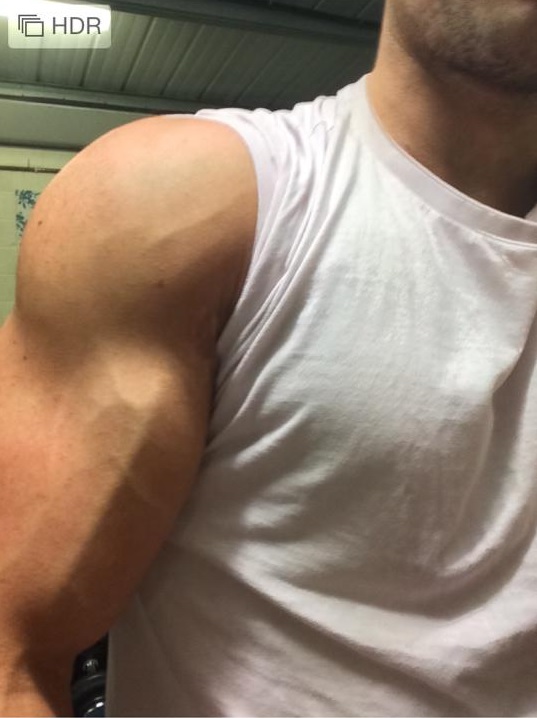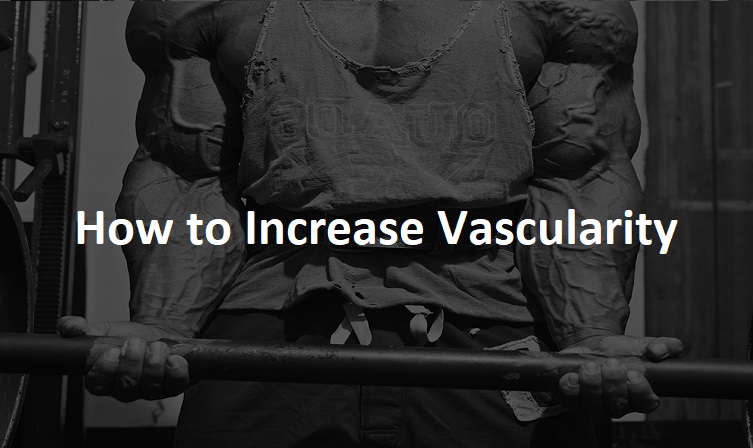How to Increase Vascularity for Roadmap Veins
A simple definition of vascularity:
Superficial veins which can be seen spiraling through a person’s muscles.
Superficial veins are located at the surface of the skin, with their physiological function being to cool the body.
When a person’s body temperature rises too high, blood is transferred from the deep veins to the superficial veins. This prevents the internal organs from overheating.
High levels of vascularity are coveted by bodybuilders due to the visible veins that make a physique look more ripped and freakish. This can give the illusion of increased muscularity and decreased body fat.
This vascular look is particularly of interest to bodybuilders during the summer months, when they’ve been cutting and want to reveal as much muscle definition and vascularity as possible. Vascularity is considered the ‘icing on the cake’ for a bodybuilder.
Contents
What Affects Vascularity?
1. Genetics
Genetics play a significant role in how vascular a person is. Specifically, how much collagen the body produces will affect the thickness of the skin.
Collagen is a protein that is responsible for increasing skin elasticity and is located in the dermis, making it less prone to wrinkling. It also plays a role in rejuvenating dead skin cells.
If a person produces high levels of collagen, they will naturally have thick skin. As a result, they’ll have more layers of skin (epidermis) covering or hiding superficial veins.
Equally, if a person has decreased collagen synthesis, this will result in thinner skin.
Thin skin is often considered an undesirable characteristic in men and women due to it being the consequence of ageing. However, one benefit of less elastic skin is increased vascularity.
This is why steroid users often display exceptional levels of vascularity due to high doses of anabolic steroids decreasing collagen synthesis (1). Older bodybuilders are also more likely to be vascular, due to collagen production gradually decreasing as the body ages. Deca durabolin (nandrolone) is the exception to this rule, with this steroid actually stimulating collagen synthesis (2).
2. Body fat %
The less subcutaneous fat a bodybuilder has, the more vascular they will be. Usually, in order to see noticeable levels of vascularity, a bodybuilder will need to have less than 10% body fat. However, 7% or less is optimal.
Thus, bodybuilders in the off-season are typically less vascular as they are following high-calorie diets, known as the bulking phase.
Note: Men with higher body fat percentages can still be vascular; however, it is less likely. This is due to excess body fat increasing the distance from where the veins are situated to the surface of the skin, due to additional fat stores.
For women, they will need to have less than 20% body fat for enhanced vascularity, and ideally 17% or lower.
When dieting, losing just a few percentages of body fat can have a considerable impact on vascularity. For example, a bodybuilder may cut from 20% to 10% and not notice any improvements. However, a further reduction from 10% to 7% may result in a bodybuilder’s cephalic vein being visible (for example).

1. Basilic and median veins 2. Cephalic vein
If someone is very lean, it doesn’t guarantee that they will have exceptional vascularity. Collagen synthesis is arguably a more important factor when determining this sensation. This is why you can have people with very low levels of body fat, yet their skin still appears to be thick.
3. Blood Flow
Enhanced blood flow can cause an increase in vascularity, hence the popularity of vasodilator supplements in bodybuilding.
A good example of this principle in action is when a man has an erection. While erect, the superficial dorsal vein can often be seen. However, when flaccid, this vein moves away from the surface of the skin and is no longer visible.
This extra blood flow can explain why bodybuilders are more vascular during a workout. While lifting weights, blood often fills the working muscles, resulting in a pump and increased vascularity.
Furthermore, a bodybuilder may become increasingly vascular during the summer months due to a person’s body’s temperature rising. Consequently, blood rushes to the surface of the skin. This is the body’s own defence mechanism in action, ensuring the internal organs don’t overheat.
Equally, when it’s cold, blood rushes inward in an attempt to keep the vital organs as warm as possible.
This is why it is very difficult for a bodybuilder to be vascular when they’re cold or shivering.
One bodybuilder who understood this principle came up with a method to increase his body temperature before stepping out on stage. He would blow hot air onto his muscles from a hair dryer instead of ‘pumping up’. His methodology was effective, with his veins rising to the surface of his skin within seconds.
You can watch the video here:
Another bodybuilder put this concept to the test, and it was effective again (see below).
This hair dryer method certainly gives evidence that increased blood flow (to the surface of the skin) can significantly increase vascularity, albeit for a limited period of time.
Higher levels of nitric oxide (N.O.) are thus desirable for vascularity. N.O. is a molecule that causes blood vessels to dilate and thus increases blood flow to the muscles.
Research has shown certain foods to be effective at increasing N.O. production; thus, adopting a diet rich in the following foods may enhance vascularity:
- Beetroot
- Dark chocolate
- Garlic
- Leafy greens
- Citrus fruits
- Pomegranates
- Nuts and seeds
- Red wine
Studies have shown beetroot juice to increase N.O. production by 21% in just 45 minutes (3).
30 grams of dark chocolate daily has been shown to cause significant increases in N.O. (4).
Aged garlic extract can increase N.O. levels by as much as 40% 1 hour after administration (5).
In one study, those who consumed spinach had salivary nitrate rise by 8x (6).
The vitamin C content in citrus fruits is found to have a positive effect on N.O levels (7)
Pomegranates can also increase N.O. due to their strong antioxidant profile (8).
L-arginine has proven to increase N.O. production. Nuts and seeds are rich in this amino acid (9).
Red wine increases nitric oxide synthase, the enzyme that is crucial for higher N.O. levels (10). However, regular consumption of alcohol isn’t recommended for bodybuilders. due to cortisol increasing. However, red wine may be an effective pre-contest due to its vasodilation and diuretic properties.

Supplements, such as l-arginine, are also taken by bodybuilders to enhance blood flow to the muscles, with users typically timing their dosages pre-workout.
Thermogenesis
Another way to increase the body’s core temperature is by stimulating thermogenesis.
This is the process that increases the body’s core temperature, thus shifting blood away from your internal organs and to the surface of your skin. The following foods may be able to stimulate this effect:
Thus, a bodybuilder could add low-sugar peanut butter sandwiches (on wholemeal bread) to their diet plan, eat a gingerbread man post-workout, sprinkle cayenne pepper on his next steak, or drink green tea before workouts. All of these, when done regularly, will increase thermogensis, boost your metabolism, and perhaps have a mild effect on vascularity.
If none of these diet tweaks appeal to you, you can always take cayenne pepper, green tea, or ginger root in supplement form, which may also prove effective.
4. Muscle Mass
For your muscles to function, they need nutrients.
Muscles obtain nutrients via your blood stream. Thus, if your muscles grow, they will require further nutrients.
A higher demand for nutrients requires more blood flow, so it is theorized that a more muscular bodybuilder will be more vascular.
There aren’t any studies or data to back this up, and so it is merely a theory.
However, this could be another reason why steroid users have more prominent veins than natural bodybuilders (on average), because they will have more muscle mass on average.
5. Water Retention/Glycogen
If there is a significant amount of water that collects between your muscle and skin (extracellular retention), then this can obscure your veins. This type of water retention can also reduce muscle definition.
Alternatively, if there is water retention inside the muscle cell (intracellular), your muscles will inflate. This is the type of water retention that is desirable for vascularity.
When bodybuilders prepare for a contest, they typically deplete carbohydrates to eliminate glycogen (energy stores) inside the muscle cell.
By depleting carbs, bodybuilders will flush out extracellular and intracellular fluid.
After fully depleting, they may see an increase in vascularity due to a reduction in fluid outside the muscle cell. Equally, their muscles will shrink temporarily due to a loss of intracellular fluid.
However, when the bodybuilders carb up again because their muscles are craving glycogen, an influx in carbohydrates will result in more water being retained inside the muscle cell.
Thus, a bodybuilder’s muscles will be inflating with glycogen, combined with very little water collecting outside of their muscles.
For every 1 gram of carbohydrate consumed, the body will retain an additional 3 grams of water (15).
Therefore, if a bodybuilder wanted to look extra vascular for a certain day, following this protocol may prove to be effective. A general guide would be:
Carb deplete for a few days by eating <30g carbs per day.
Then, the day before you want an increase in vascularity, carb load with high G.I. (glycemic index) foods—eating 2.5 grams of carbohydrates per lb of body weight.
Then, on the actual day, carbohydrates should remain high.
If carbohydrates or calories go too high during this period, there is a chance the person can spill over, meaning some water might be distributed outside of the muscle cell. Not eating more than 2.5 grams of carbs per lb of body weight (when carbing up) will reduce the chances of this happening.
High-GI foods will replenish glycogen stores faster and more effectively than low-GI foods (16).
Examples of high-glycemic foods:
- White baguette: 95
- Coco Pops, 77
- English muffin: 70
- Waffles: 76
- Rice cakes: 70–91
- White bread: 73
- Cornflakes: 93
- White rice: 89
Alcohol Effect
Some bodybuilders can become vascular when drinking alcohol. This is due to ethanol being a diuretic (17), thus eliminating extracellular water retention. This is why some bodybuilders drink red wine the night before a competition, to make them appear more ‘dry’.
Here’s a picture of me when I was around 7% body fat during a workout. This was the day after drinking a considerable amount of alcohol.

I rarely ever drink alcohol, and it’s even more rare for veins to appear through my arms (even when I’m very lean). Thus, these were some freaky veins, which is further evidence that alcohol has a positive effect on vascularity.
Drinking more water will also determine how visible your veins are. This is because the more water you drink, the more water your body will flush out.
This is a defence mechanism by the body to stop it from retaining too much water.
Summary

For increased vascularity (in the short term):
- Carbohydrate cycling
- Consume alcohol
- Use a hairdryer
For increased vascularity (long-term):
- Increase blood flow via the utilization of N.O. producing foods in diet
- Lower body fat
- Regular consumption of foods that stimulate thermogenesis (cayenne pepper, green tea, and ginger)
- Build more muscle
- Drink more water
- Sun exposure (decreased collagen)
There are several ways for a bodybuilder to increase vascularity, with some methods having a profound effect and others only mild.
Here are two standard recommendations when trying to increase vascularity significantly:
- Decrease body fat %
- Drink more water (or take diuretic supplements)
Just by focusing on these two factors, a bodybuilder will almost certainly see an increase in vascularity (no matter what their genetics are).
Excluding genetics, losing body fat is possibly the number one factor for increasing vascularity. This is something that almost everyone can control by adopting a calorie-deficit diet.
References
(1) https://journals.sagepub.com/doi/abs/10.1177/036354659202000305
(2) https://www.ingentaconnect.com/content/doaj/2335075x/2016/00000017/00000004/art00003
(3) https://www.ncbi.nlm.nih.gov/pubmed/29370244
(4) https://www.ncbi.nlm.nih.gov/pubmed/22156352
(5) https://www.ncbi.nlm.nih.gov/pubmed/12052435
(6) https://www.ncbi.nlm.nih.gov/pubmed/24120618
(7) https://www.ncbi.nlm.nih.gov/pubmed/24333161
(8) https://www.ncbi.nlm.nih.gov/pubmed/16626982
(9) https://www.ncbi.nlm.nih.gov/pmc/articles/PMC4882723/
(10) https://www.ncbi.nlm.nih.gov/pubmed/12575978
(11) https://www.ncbi.nlm.nih.gov/pmc/articles/PMC3699483/
(12) https://www.nature.com/articles/0801101
(13) https://www.ncbi.nlm.nih.gov/pmc/articles/PMC3408800/
(14) https://www.ncbi.nlm.nih.gov/pubmed/24951981
(15) https://www.ncbi.nlm.nih.gov/pubmed/25911631
(16) https://www.ncbi.nlm.nih.gov/pmc/articles/PMC6019055/
(17) https://www.ncbi.nlm.nih.gov/pmc/articles/PMC5537780/
Inside Bodybuilding is a team of medical professionals and physicians with specialized knowledge and experience regarding bodybuilding and PEDs.



